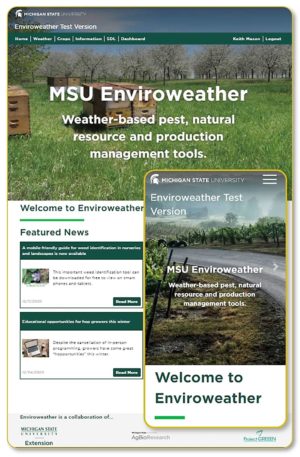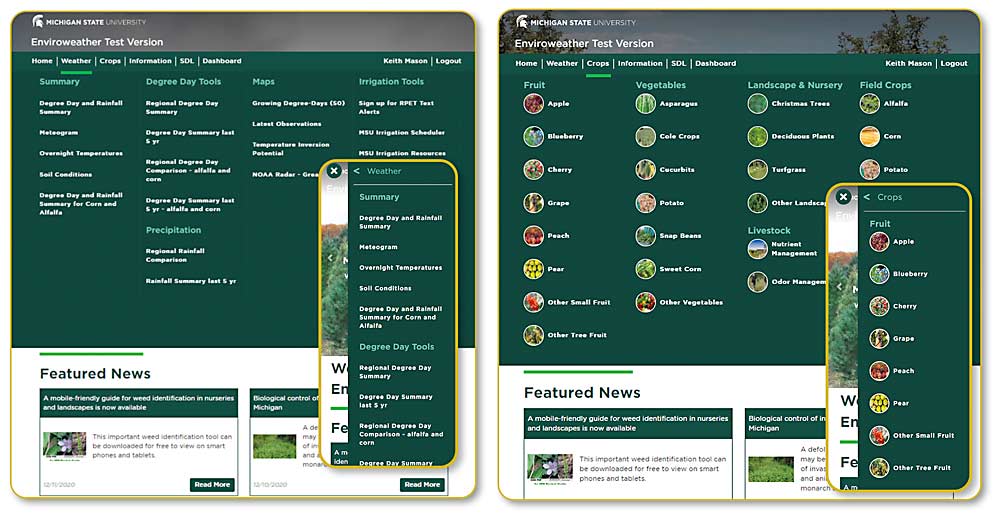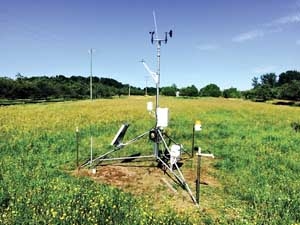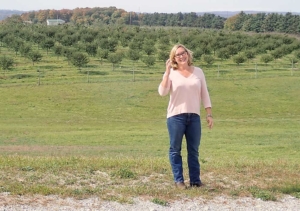
Michigan State University’s Enviroweather program, a crucial weather-monitoring tool for the state’s fruit growers and extension educators, is redesigning its website to be easier to use, more customizable and geared toward viewing on smartphones and tablets.
“The approach we had before was to try to provide everything from our models,” said Keith Mason, Enviroweather’s program and outreach coordinator. “Now, we tailor the output more for what the user really needs, but we’ve included options to get the detailed information.”
The test version of the new site, at alpha.enviroweather.msu.edu, went live in June. The current site is still in use. Both websites will remain accessible during the test phase, which will likely extend through the 2021 growing season. When the current site is eventually decommissioned, the new site will be directly accessed through the original web address, enviroweather.msu.edu.
The redesign team thought it best to release the test website while the current version is still in use. That way, users have plenty of time to familiarize themselves with the new format before the site switches over, said Mason, who is coordinating the redesign project.
Since 2006, Enviroweather has provided weather data for Michigan (and now Wisconsin) agricultural producers, natural resource managers, researchers and students. The program grew from 40 automated weather stations in Michigan to 101 stations now in Michigan and Wisconsin. The temperature, wind speed and direction, relative humidity, soil temperature, moisture, leaf wetness and other data gathered by the stations are transmitted to the website, which uses them to create weather-based models for pest and disease risk, such as codling moth and apple scab.

The current website has done a fine job over the years, but it is not as intuitive as users would like. It doesn’t display well on mobile devices, for example — and over half of Enviroweather’s access now comes from mobile devices, Mason said.
“That’s what growers asked us for,” he said. “They carry their phones around in their trucks. They need something they can work with on a smaller screen.”
Mason, based on MSU’s campus in East Lansing, is the only full-time staff member devoted to the Enviroweather program. He works with a website designer, database manager and field operations manager, all half-time positions. Jeff Andresen, MSU professor of geography, serves as program director and consults on weather data decisions and strategic planning but is not involved in day-to-day management of the website.
“That’s a small shop for the amount of stuff we do,” Mason said. “We have to collaborate with other groups on campus or look for outside help in order to do projects like this.”
Enviroweather partnered with MSU’s Remote Sensing and Geographic Information Science and Outreach Services, which specializes in geospatial sciences and developing websites to display data-based content. RS&GIS provided a template for the Enviroweather redesign and has done most of the programming for the user interfaces on the site, he said.
On the test site, users can create their own accounts and choose the weather stations, crop models and weather models that are important to them, all of which can be saved and accessed quickly from the dashboard, Mason said.
At the behest of Michigan cherry growers, Enviroweather collaborated with MSU entomologists and extension educators to develop a spotted wing drosophila model for the new site, which growers can use to predict when their cherries will become susceptible to SWD infestation. Tree fruit growers use the site more than any other group, responsible for about 80 percent of its access, Mason said.
“Tree fruit growers have been our most important allies in some respects,” he said. “They’ve been vocal about expanding and providing feedback on the network, and finding ways to put in new stations. It really helps to have engaged industry stakeholders, and we are very grateful for their input and support.” •
—by Matt Milkovich








Leave A Comment